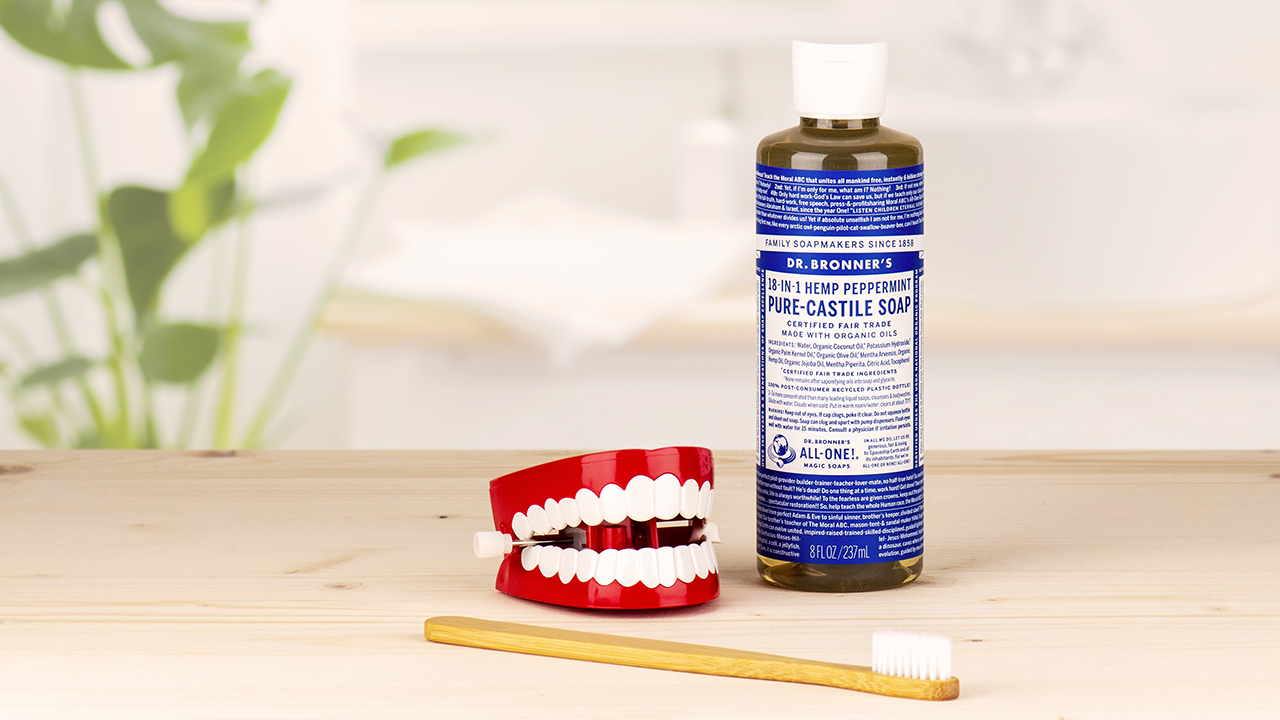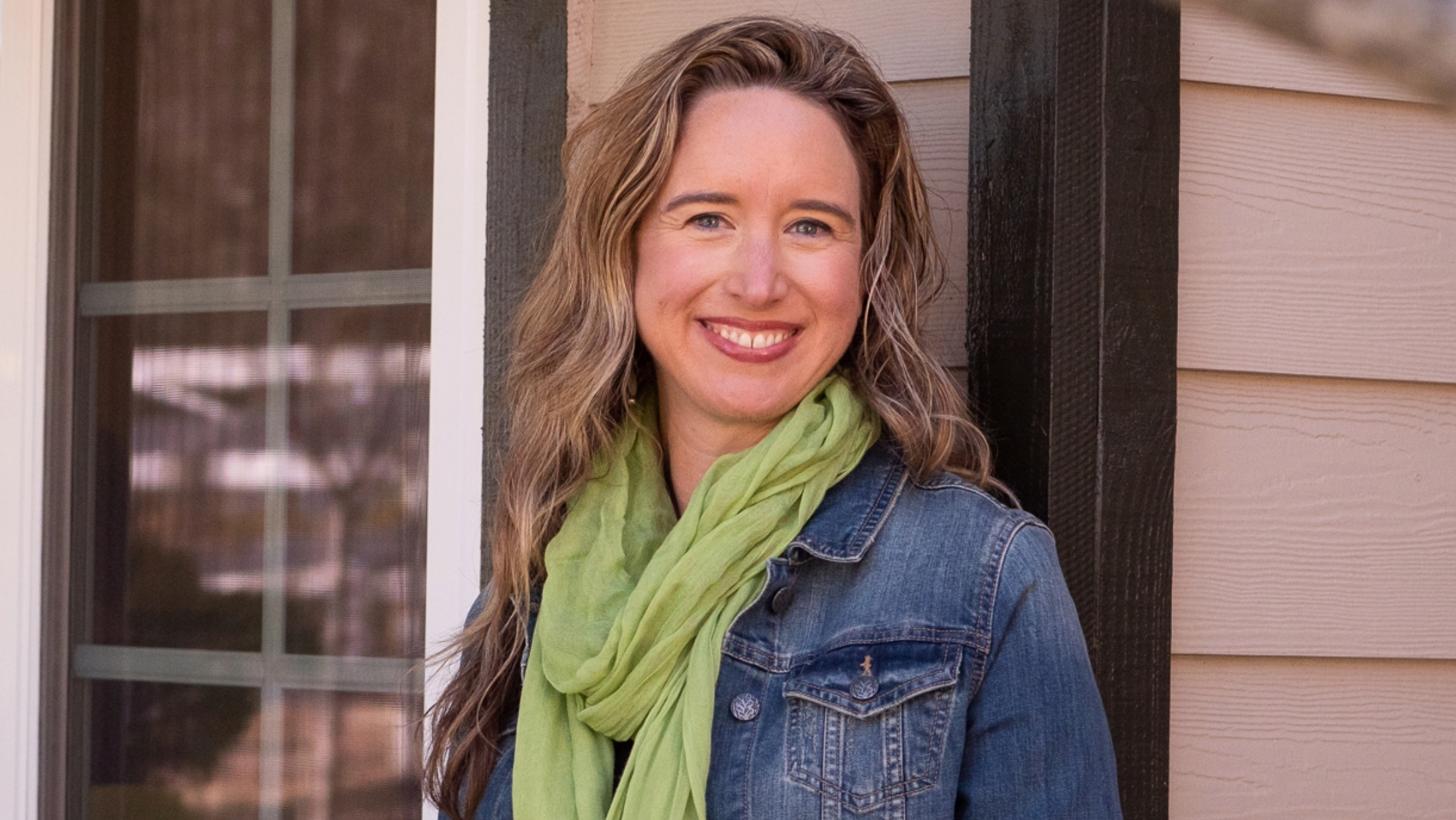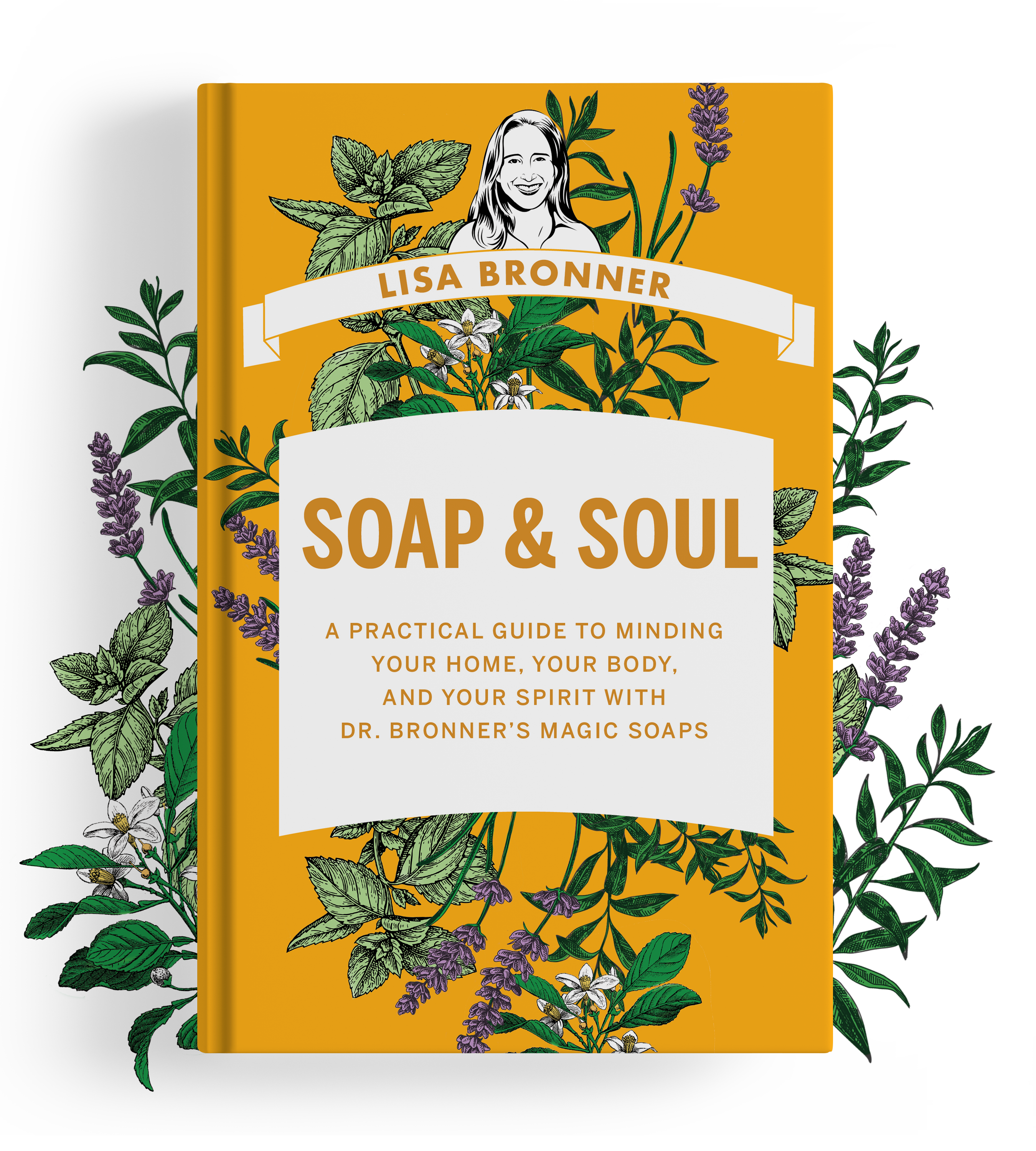
We used to kid my grandfather (aka Dr. Bronner) that he included teeth brushing in Castile Soap’s original 18 uses only because he could take his teeth out of his mouth. He wore dentures during the years I knew him. While you can indeed brush your pearly whites effectively with the soap, it does taste like soap. Not harmful, but not my thing. In this post, learn how to clean oral appliances, CPAPs and more!
However, Castile Soap, with its olive/coconut oil base, makes a fantastic non-abrasive, effective cleaner for dentures and oral appliances. Sal Suds Biodegradable Cleaner, the inimitable all-surface cleaner, plays its part excellently, too.
It’s not just about keeping these items clean. It’s also about cleaning them in ways that are healthy for us and preserve the longevity of the device. You certainly can knock out all germs on them using bleach. However, the harm to people bleach causes is well-documented, and to keep it handy in your bathroom may be asking for trouble with little ones or pets. Further, bleach can weaken, discolor, or deteriorate materials over time.
I wore a retainer for about 20 years post-braces and have since switched to a nightguard. Perhaps TMI, but know that these recommendations are ones I have followed personally to good effect for a very long time.
Castile Soap and Sal Suds work almost interchangeably for cleaning the items listed below. Both rinse cleanly and leave no taste behind. However, there are reasons which I share below that make me reach for one over the other depending on the job. If you are particularly drawn to either Castile Soap or Sal Suds, go with it. Both work for all of this.
Why Not Just Use Toothpaste?
As innocuous as toothpaste may seem, its slight abrasiveness that is awesome for polishing our teeth will polish the surface right off these appliances. They are not as durable as our teeth. While you may not care if your retainer loses its shine, you would definitely care if your dentures do. You need a gentler cleaner.
Even baking soda, a hero of the green care arsenal, is too abrasive for brushing these devices, though you’ll see below a recommendation of a baking soda soak for dentures.
Cleaning Nightguards, Retainers, Teeth Whitening Trays & Other Removable Oral Appliances
Brush daily with Castile Soap and a soft toothbrush:
- Wet the device.
- Add a drop or two of soap to a soft toothbrush.
- Brush gently but thoroughly.
- Rinse well.
Follow manufacturer’s recommendation on how to store if not worn immediately. Some need to be soaked, but most should be air-dried before storing. Do not store a device when wet as this encourages microbe growth.
As I’ve said, I’ve used the Castile Soap to clean my nightguard for years. I already have Castile Soap beside my sink for face washing. And handwashing. And makeup brush washing. You get the picture. It’s right there, and it washes everything. If Sal Suds is your preference, though, it’s just as easy to tuck a bottle under the sink for this purpose.
Cleaning Headgear
I wore this, too, in my day. Depending on how much of it is washable, either submerge the whole thing in a sink with a squirt of Castile Soap or Sal Suds, or if only certain parts can get wet, use a wet washcloth with a few drops of soap and wash well. Rinse and let dry.
Cleaning Dentures
Brushing: After removing dentures, rinse them under running water. Then put a couple drops of Castile Soap on a soft toothbrush and brush thoroughly. Rinse well.
Soaking: Most dentures should be soaked when not in use. Follow manufacturer’s direction on this. After cleaning, place them in a cup of water with a small squirt of Castile Soap, about ½ tsp. (2.5 mL). You can also add 1 tsp. (5 mL) of baking soda. When you’re ready to insert them, rinse them well. Remember not to brush dentures with baking soda as this can dull the finish over time.
Partial dentures can also be cleaned this way. Partial dentures often have metal parts. These in particular can corrode with harsh cleaners. Gentle, non-abrasive cleaners like Castile Soap or Sal Suds are best.
Cleaning CPAP Machines
A continuous positive airway pressure device, used for treating sleep apnea and affectionately known as a CPAP machine, is not an oral appliance per se, but nightly use necessitates regular cleaning. Dr. Bronner’s can help with this, too.
Follow manufacturer’s recommendation on what parts to wash and how often. Likely you’ll need to wash the mask, tubing, and headgear.
- Submerge washable parts in a bowl or sink of warm water with a small squirt of Sal Suds, approximately a half teaspoon, or 2.5 mL. Make sure the solution has gone through the tubing so that no air bubbles are trapped.
- Allow to sit for 30 minutes.
- Wash parts gently with a washcloth.
- Rinse all parts, running water through the tubing to rinse thoroughly.
- Towel parts dry and then allow to air dry thoroughly before reassembling. Hang the tubing gently over a towel rod, hanger, or shower so that moisture can escape.
I recommend Sal Suds over the Castile for CPAP parts because Castile Soap reacts with the minerals in hard water and leaves a harmless but unsightly film. However, you can still use the Castile if you prefer. If you have soft water, there will be no film, or with hard water, you can eliminate the film by doing an additional vinegar rinse: dilute ½ cup (120 mL) of vinegar in your bowl/sink of water. Rinse items through and air dry. Or you can just leave the film be. It is harmless.
Despite numerous online recommendations I’ve read that advise washing CPAP parts with vinegar and soap together, do not do this. Do not use vinegar with either Castile Soap or Sal Suds. Vinegar reacts with the Castile, producing goo, and does not improve the cleaning ability of the Sal Suds.
We pay a lot for these appliances, and they do important work. Further, they go in our mouths, which means anything on them ends up in us. This isn’t even a discussion of the permeability of our skin. This is about literally swallowing substances.
We want to be sure that what we use to clean these devices is effective and safe to ensure these appliances can do their jobs for a good many years.
Further reading
Sal Suds cleaner shows >60% biodegradation after 28 days per ISO 14593.



I’ve been using Dr. Bronner’s unscented baby Castile soap on my CPAP gear since I switched from Ivory a couple of years ago and this is much, much better. It re-defines ‘squeaky clean’. I haven’t had any problem with residue in our water, but I would try Sal Suds if it was unscented.
Also, I agree that you shouldn’t mix vinegar and soap together. Vinegar is acid and soap is slightly basic – they would cancel each other to some degree. I use soap once a week, then a separate soak in water/vinegar every other week.
Excellent! Thanks for sharing this, Ken!
I’m curious why Sal Suds for CPAP equipment instead of the unscented baby soap, which is what we use. I had not thought about using Sal Suds for CPAP because the pine scent. Plus, limonene is a lung irritant, so I’m not sure we’d want to breathe in any residue.
Hi there – Both products will effectively clean the CPAP apparatus. The Sal Suds is a superbly clean rinsing product that will not leave any residues to irritate breathing. In hard water, the Castile might cause a cloudiness to the clear tubing, which is harmless but may be considered unsightly. Please use whichever of the two you prefer.
Hi there! I have one of those little sonic-cleaner machines for my custom fit night guard (also used for dentures which I don’t have). I have the cleaner tablets but I wonder if Sal Suds or Castile Soap might work in this sonic cleaner appliance?
Hi there – I apologize for my delay in responding. I would need to see what the cleaner tablets are in order to know if Sal Suds could substitute. Could you send a product name? I looked up what these sonic cleaners use and there is a great variety.
Thank you for this informative article! For soaking dentures in Castile soap, may I please know how long should I soak it for? Thanks!
Hi Marissa – According to my research (check out this article cited by the American Dental Association in their guidance), you can leave your dentures in your denture cleaning solution overnight. Rinse them thoroughly before using. If you’re soaking in baking soda, rinse that off and don’t brush it. The slight abrasion could wear on the dentures.
Hello !
May I ask you what the mouth guard you use is made out of?
According to my research all plastics and silicon are not inert and all of them leach out extremely unhealthy chemicals when coming in to contact with saliva ( which is an extremely powerful chemical extracting agent) and are then absorbed in to our bodies while we sleep.
Thank-you very much !
Roy Firus
Hi Roy- I believe the one I wear is made of silicone. I will certainly be looking into your concerns. Yes, saliva is our bodies’ first step in digestion and has some power to it.
can i use this in a carpet cleaner machine? If so what is the ratio? Thanks
Hi Karen- Sal Suds and Castile Soap can both be used in a carpet cleaner. The amount varies based on which you’re using and what kind of carpet cleaner you have. Check out my blog post for the specifics, https://www.lisabronner.com/cleaning-carpets-with-sal-suds/
Thanks for this. I just got a night guard and didn’t want to use the chemical soak. I have Castile soap and Sal Suds in both bathrooms so this makes it easy, safe and convenient for me. Is the all purpose spray strong enough if I brush them or do I need the concentrate?
Hi Rosemary- The All-Purpose Spray should be fine. Use several sprays followed by brushing with a toothbrush. Recently I’ve been cleaning my bite guard with a squirt from the foaming pump dispenser next to my bathroom sink. It’s a dilution of 1 part soap and 3 parts water. Super easy way to do it!
When you use Dr.Bronner’s castile soap to clean your dentures do you still need to disinfect them? I’ve used the castile sopa for everything for years & years. I wouldn’t be without it and I love reading the label, especially when I’m soaking in the tub.
Hi Pam- With regular daily brushing with soap, there’s no need to disinfect them. It’s great to hear the label resonates with you! Have you read my post about how the label came to be? https://www.lisabronner.com/how-the-label-was-born/
I use Dr. Bronner’s to clean my Neti pot after each use. I want to thoroughly clean anything that is shooting water into my head! Lol
Hi Andrea- Excellent! Our soaps are great for cleaning Neti pots and such!
What about Water flossers?
Hi Shellaine- To clean water flossers, fill the tank with warm water and a couple drops of Sal Suds or squirt of the Castile soap. Run solution through the tubing. The follow up with a run of clear water. Let air dry. Soak the various tips in a sink/bowl of warm water and Sal Suds or Castile. Wash with cloth and rinse well. Let air dry.
Hello! I was wondering if you should share where you air dry your waterpik and tooth brushes? I know it’s not super sanitary to do so in the bathroom but I’m a bit puzzled as to where then. Thank you!
I just purchased a $15 bottle of Heal Earth. Smells good and I will post in the future how this soap will work for showering or bathing.
Do you think using sal sud or dr bronners would help to clean electronic toothbrush heads?
Hi Suzy – Yes, I think both would work well. Soak them in hot water with a dash of either product. Let them sit for a bit. Then scrub and rinse them. Let them air dry.
Hi! Love the new look of the blog, it feels cleaner! I’ve always washed my nightguard with Dr. Bronner’s Castile Soap mainly because it’s easier to find, the unscented one prevents me from feeling some taste or scent in it that I would get from other soap and it rinses better. But now that I’ve found an easier way to buy Sal Suds I’m curious if it would be the same or I’ll risk a small “taste”? What do you think?
Hi Adrian- I’m glad you like the new look! Sal Suds is exceedingly clean rinsing, so there shouldn’t be any residue taste left behind. Both work equally well!
I don’t have a c-pap or dentures, but I do wear retainers, and I soak them daily, in my Dr. Bronners’ diluted, Castile liquid soap and a bit of distilled water. I have been using this mixture for about 5 years and I wouldn’t use anything else! My retainers are squeaky clean every morning!
Excellent!